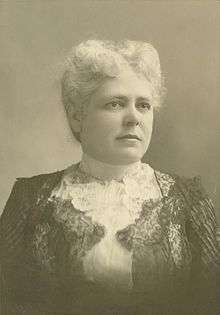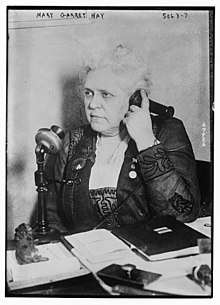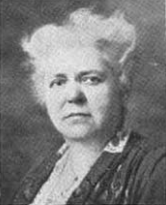Mary Garrett Hay
Mary "Mollie" Garrett Hay (August 29, 1857- August 29, 1928)[1] was an American suffragist, community organizer, and president of the Women's City Club of New York, the Woman Suffrage Party and the New York Equal Suffrage League. Hay was known for creating woman's suffrage groups across the country. She was also close to the notable suffragist, Carrie Chapman Catt, with one contemporary, Rachel Foster Avery, stating that Hay "really loves" Catt.[2]
Mary Garrett Hay | |
|---|---|
 | |
| Born | August 29, 1857 Charlestown, Indiana |
| Died | August 29, 1928 (aged 71) Pelham, New York |
| Nationality | American |
| Occupation | Suffragist Community organizer |
| Partner(s) | Carrie Chapman Catt |

Biography
Hay was born in Charlestown, Indiana, in 1857.[3] Her mother died when she was young and she would travel with her father, who was an important Republican, when he visited patients or had political work.[4] She was a devout Presbyterian.[5] Hay attended the Western Female Seminary between 1873 and 1874,[5] where she studied to become a pharmacist and later worked for her father's pharmacy.[4] Hay became involved in the temperance movement and then later joined a suffrage group where she met Carrie Chapman Catt,[6] possibly at a National American Woman Suffrage Association (NAWSA) convention.[7] In the summer of 1895, Hay and Catt moved in together for a while.[7] When Catt's husband, George died in 1905, Hay moved in with Catt permanently.[8] Hay took over the household responsibilities.[2]
In 1896, when California was creating its state constitution, Hay, along with women she organized, worked to have women's suffrage be included, though the referendum for women to vote was narrowly defeated.[4] Her work in California gave her valuable experience in organizing.[9] Hay created suffrage groups across the country.[4] In November 1895 she and the Rev. Henrietta G. Moore of Ohio organized the state convention that founded the West Virginia Equal Suffrage Association. In 1899, she and Catt traveled through 20 different states, made numerous speeches and attended 15 conventions.[8] At conventions, like one in Topeka in 1918, Hay advocated creating citizenship and civics classes for women.[10] Hay served as the president of the New York Equal Suffrage League from 1910 to 1918.[11] In 1912, she was the president of the group, The Daughters of Indiana.[12] She served as president of the Woman Suffrage Party (WSP) in 1915.[13] During her time in WSP, she organized the enrollment of thousands of women to vote in the state of New York.[14] Hay In 1919, she was also the president of the Women's City Club of New York (WCC).[15] Hay was nominated to the WCC in order to bring a strong leadership role to the civic organization.[16] Hay was also the president of the New York City League of Women Voters between 1918 and 1923.[11]

Hay became one of the first women in the Eastern United States to join a political party when she became a Republican.[3] She served as chair of the Republican Women's National Executive Committee in 1919 and 1920.[11] Hay ensured that women's suffrage remained an important plank in the Republican Party of the time.[17] She encouraged other women to join the party.[18] In 1920, Hay and Catt cast ballots for the first time for president, together.[19]
Hay died in Pelham at home of a heart attack.[3] She was found by Catt inside of their home.[20] Catt created a monument to Hay where she was buried, Woodlawn Cemetery.[21] After Catt died in 1947, she was buried next to Hay.[2] Their headstone reads, "Here lie two, united in friendship for 38 years through constant service to a great cause."[22]
In popular culture
Winter Wheat, a new musical by Cathy Bush about the ratification of the 19th Amendment in Tennessee, premiered at the Barter Theatre in 2016. The original version of the play had a limited run at the Barter in 2014. Hay and Carrie Chapman Catt are characters in the play. The show also features anti-suffragist Josephine Anderson Pearson and Tennessee state representative Harry T. Burn, who cast the deciding vote for ratification in Tennessee.[23]
References
Citations
- "Augusztusban született". Nőkért.hu (in Hungarian). 2012-07-31. Retrieved 2017-03-03.
- Rupp 1997, p. 585.
- "Mary Garrett Hay's Watchword to Women in Politics Was: 'Be Nice to the Men;' Fought for Suffrage from Girlhood". The Brooklyn Daily Eagle. 2 September 1928. Retrieved 1 March 2017 – via Newspapers.com.
- Gray, Lillian (28 June 1903). "Mary Garrett Hay: Organizer of Women's Associations". The Dacatur Herald. Retrieved 1 March 2017 – via Newspapers.com.
- Louis 1971, p. 163.
- Beam, Amanda Hillard (1 September 2015). "A lost daughter: How Charlestown's Mary Garrett Hay changed the world". News and Tribune. Retrieved 2 March 2017.
- Faderman 1999, p. 62.
- Faderman 1999, p. 63.
- "Mary Garrett Hay". National Women's History Museum. Retrieved 1 March 2017.
- Thomen, Kate (5 May 1918). "Five Thousand at the Biennial". The Topeka Daily Capital. Retrieved 4 March 2017 – via Newspapers.com.
- "Hay, Mary Garrett, 1857–1928. Papers of Mary Garrett Hay in the Woman's Rights Collection, 1918-1923: A Finding Aid". Harvard University Library. Retrieved 4 March 2017.
- "Daughters of Indiana Elect". The Indianapolis Star. 16 January 1912. Retrieved 4 March 2017 – via Newspapers.com.
- Van Voris 1987, p. 118.
- Blackwell, Alice Stone (25 August 1917). "High Lights of the City Campaign". The Woman Citizen. 1: 228.
- "Liquors for Women". Harford Courant. 20 August 1919. Retrieved 1 March 2017 – via Newspapers.com.
- Simmons, Eleanor Booth (17 February 1918). "Women's City Club May Come Into Its Own". New York Herald. Retrieved 4 March 2017 – via Newspapers.com.
- Taaffe, Lillian E. (10 June 1920). "Women Given '50-50' Share in G.O.P. Party". Star Tribune. Retrieved 4 March 2017 – via Newspapers.com.
- "Cheers Greet Women as They Enter Politics". The Indianapolis Star. 3 April 1919. Retrieved 4 March 2017 – via Newspapers.com.
- "Mrs. Carrie Chapman Catt and Miss Mary Garrett Hay, suffrage workers". St. Louis Post Dispatch. 5 November 1920. Retrieved 4 March 2017 – via Newspapers.com.
- Van Voris 1987, p. 208.
- Van Voris 1987, p. 219.
- Wade, Betsy (30 December 2005). "History Opens Its Heart to Carrie Chapman Catt". Women's eNews. Retrieved 4 March 2017.
- http://www.broadwayworld.com/norfolk/article/World-Premiere-of-WINTER-WHEAT-Begins-Performances-729-at-Barter-Theatre-20140723
Sources
- Faderman, Lillian (1999). To Believe in Women: What Lesbians Have Done for America - A History. New York: Houghton Mifflin Company. ISBN 9780547348407.CS1 maint: ref=harv (link)
- Louis, James P. (1971). "Hay, Mary Garrett". In James, Edward T.; James, Janet Wilson; Boyer, Paul S. (eds.). Notable American Women, 1607–1950: A Biographical Dictionary. Cambridge, Massachusetts: Harvard University Press. pp. 163–165. ISBN 978-0674627345.CS1 maint: ref=harv (link)
- Rupp, Leila J. (1997). "Sexuality and Politics in the Early Twentieth Century: The Case of the International Women's Movement". Feminist Studies. 23 (3): 577–605. doi:10.2307/3178388. JSTOR 3178388.CS1 maint: ref=harv (link)
- Van Voris, Jacqueline (1987). Carrie Chapman Catt: A Public Life. New York: The Feminist Press at The City University of New York. ISBN 9781558611399.CS1 maint: ref=harv (link)
External links

- Mary Garrett Hay at Find a Grave
- Papers of Mary Garrett Hay